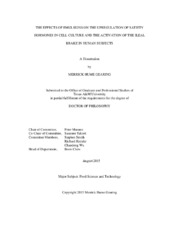| dc.description.abstract | To treat obesity, one approach is developing food products formulated to trigger the ileal brake, a gastric feedback mechanism that induces satiety, the prolonged feeling of fullness. PYY and GLP-1, biomarkers of the ileal brake, are secreted from the ileum upon macronutrient exposure. Circulating PYY and GLP-1 bind to receptors in the hypothalamus, suppressing appetite and food intake. In three research phases, the hypothesis that two orally consumed emulsions, composed of palm and fish oil, induce satiety and reduce energy intake, was tested.
In phase one, it was hypothesized that the emulsions promoted the secretion of PYY and GLP-1 from the murine intestinal cell line, STC-1. The STC-1 cells were treated with each emulsion and the hormone response was assayed. The results demonstrated that the emulsions promoted PYY and GLP-1 secretion from the STC-1 cultures. These findings suggest that the emulsions may have potential as satiety inducing agents in human volunteers.
In phase two, it was hypothesized that a formulated fruit and dairy smoothie-type beverage could serve as vehicle for the satiety inducing emulsions. Beverages with or without the emulsions constituted the treatments. To test this hypothesis, subjective and objective analyses were performed. Subjective analyses using human volunteers compared sensory aspects of each treatment. Objective analyses using appropriate instrumentation compared the viscosities, pH and color of each treatment. There were no statistically significant differences in the subjective and objective results, confirming that the beverage is a suitable emulsion vehicle.
Phase three tested the hypothesis that the treatments induced satiety, reduced energy intake and induced a satiety hormone response in human subjects. 10 subjects consumed three treatments in a crossover study in which self-reported satiety, food intake, and satiety hormones were investigated. Blood sample analyses and completed satiety questionnaires were used to assess treatment effects over a 180 minute interval. Following the 180 minute interval, subjects consumed a satiety meal to achieve satiation, at which point food intake was measured. Consumption of each treatment did not demonstrate significant differences for any subject-reported satiety, biomarker analysis and food intake. | en |


